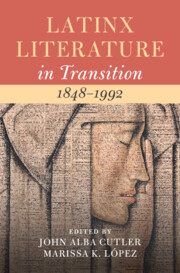Book contents
- Latinx Literature in Transition, 1848–1992
- Latinx literature in transition
- Latinx Literature in Transition, 1848–1992
- Copyright page
- Dedication
- Contents
- Figures
- Contributors
- Acknowledgments
- Introduction
- Part I Space
- Part II Being
- Part III Time
- Part IV Form
- Chapter 13 Entre Balas y Rugidos
- Chapter 14 Modernism’s Workshops
- Chapter 15 Lyrical Mobilities
- Chapter 16 Bullets, Guns, and Tattoos
- Part V Labor
- Bibliography
- Index
- References
Chapter 14 - Modernism’s Workshops
Printing Latinx Literary Modernities in New York City
from Part IV - Form
Published online by Cambridge University Press: 10 April 2025
- Latinx Literature in Transition, 1848–1992
- Latinx literature in transition
- Latinx Literature in Transition, 1848–1992
- Copyright page
- Dedication
- Contents
- Figures
- Contributors
- Acknowledgments
- Introduction
- Part I Space
- Part II Being
- Part III Time
- Part IV Form
- Chapter 13 Entre Balas y Rugidos
- Chapter 14 Modernism’s Workshops
- Chapter 15 Lyrical Mobilities
- Chapter 16 Bullets, Guns, and Tattoos
- Part V Labor
- Bibliography
- Index
- References
Summary
This chapter locates an important constellation of Latinx literary modernities in the editorial offices and print shops of New York City’s late nineteenth- and early twentieth-century Spanish-language press. In contrast to familiar expressions of literary modernity in Spanish and English centered on literary autonomy, those of interest in this chapter pursued the possibilities of an expanding and increasingly interconnected world of print for achieving democracy and social justice. In New York City, that pursuit began in the context of Cuba’s and Puerto Rico’s anticolonial struggle against Spain – in the form it took in the 1880s and 1890s as José Martí built the coalition that organized Cuba’s final independence war with Spain. Some of his collaborators, including Rafael Serra and Sotero Figueroa, made Cuba’s revolutionary movement a source of ambitious thinking about the interrelationship of modern media, democracy, and social justice. Their ideas help to reveal continuities that run through early twentieth-century Spanish-language periodicals in New York City and their late nineteenth-century predecessors – including those associated with the literary movement of modernismo. Across those periods, Latinx editors and writers launched visionary and largely understudied innovations designed to make modern media a means of enabling participation in creating just democracies.
Keywords
- Type
- Chapter
- Information
- Latinx Literature in Transition, 1848–1992 , pp. 242 - 259Publisher: Cambridge University PressPrint publication year: 2025

